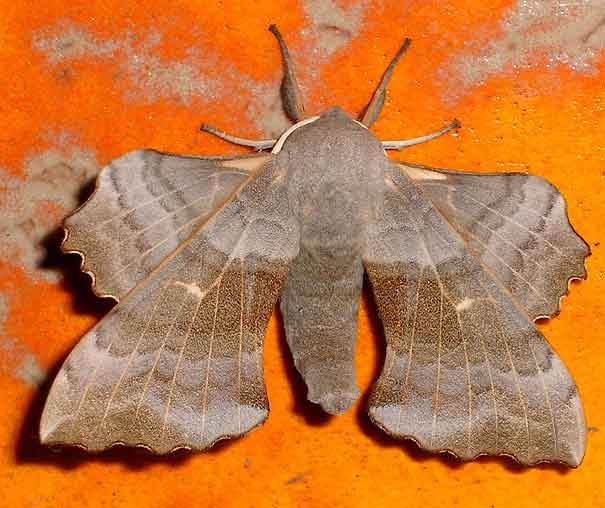
Laothoe populi (*)
Superregnum: Eukaryota
Cladus: Unikonta
Cladus: Opisthokonta
Cladus: Holozoa
Regnum: Animalia
Subregnum: Eumetazoa
Cladus: Bilateria
Cladus: Nephrozoa
Cladus: Protostomia
Cladus: Ecdysozoa
Cladus: Panarthropoda
Phylum: Arthropoda
Subphylum: Hexapoda
Classis: Insecta
Cladus: Dicondylia
Subclassis: Pterygota
Cladus: Metapterygota
Infraclassis: Neoptera
Cladus: Eumetabola
Cladus: Endopterygota
Superordo: Panorpida
Cladus: Amphiesmenoptera
Ordo: Lepidoptera
Subordo: Glossata
Cladus: Coelolepida
Cladus: Myoglossata
Cladus: Neolepidoptera
Infraordo: Heteroneura
Cladus: Eulepidoptera
Cladus: Ditrysia
Cladus: Apoditrysia
Cladus: Obtectomera
Cladus: Macroheterocera
Superfamilia: Bombycoidea
Familia: Sphingidae
Subfamilia: Smerinthinae
Tribus: Smerinthini
Genus: Laothoe
Species: Laothoe populi
Subspecies: L. p. populeti – L. p. populi
Name
Laothoe populi (Linnaeus, 1758)
Synonyms
Sphinx populi Linnaeus, 1758
Smerinthus populi rufescens de Selys-Longschamps, 1857
Merinthus palustris Holle, 1865
Merinthus populi salicis Holle, 1865
Smerinthus populi rufescens Fuchs, 1889
Smerinthus borkhauseni Bartel, 1900
Smerinthus populi fuchsi Bartel, 1900
Laothoe populi pallida Newnham, 1900
Smerinthus populi violacea Newnham, 1900
Amorpha populi pallida Tutt, 1902
Amorpha populi suffusa Tutt, 1902
Smerinthus populi decorata Schultz, 1903
Smerinthus populi cinerea-diluta Gillmer, 1904
Smerinthus populi ferruginea-fasciata Gillmer, 1904
Smerinthus populi ferruginea Gillmer, 1904
Smerinthus populi grisea-diluta Gillmer, 1904
Smerinthus populi grisea Gillmer, 1904
Smerinthus populi pallida-fasciata Gillmer, 1904
Smerinthus populi rufa-diluta Gillmer, 1904
Smerinthus populi rufa Gillmer, 1904
Smerinthus populi subflava Gillmer, 1904
Smerinthus populi rectilineata Klemensiewicz, 1912
Amorpha populi angustata (Closs, 1916)
Amorpha populi philiponi Huard, 1928
Amorpha populi flavomaculata Mezger, 1928
Amorpha populeti intermedia Gehlen, 1934.
Amorpha populi depupillatus (Silbernagel, 1943)
Laothoe populi albida Cockayne, 1953
Laothoe populi basilutescens Cockayne, 1953
Laothoe populi moesta Cockayne, 1953
Laothoe populi bicolor (Lempke, 1959)
Laothoe populi minor (Vilarrubia, 1973)
Photos
Sphingidae of the Eastern Palaearctic [1]
Vernacular names
Deutsch: Pappelschwärmer
English: Poplar Hawk-moth
español: Esfinge del chopo; cuerno verde
suomi: Poppelikiitäjä
français: Sphinx du peuplier
magyar: Nyárfaszender
italiano: Sfinge del pioppo
Nederlands: Populierpijlstaart
polski: Zawisak topolowiec; Nastrosz topolowiec
русский: Topolevyi Brazhnik
svenska: Poppelsvärmare
Laothoe populi, the poplar hawk-moth, is a moth of the family Sphingidae. The species was first described by Carl Linnaeus in his 1758 10th edition of Systema Naturae. It is found throughout the Palearctic region and the Near East and is one of the most common members of the family in the region.[2] It is distinctive due to its habit of resting with its hindwings held further forward than (but still half hidden by) the forewings.
Adults may be seen from May to September, and do not feed, not having a functional proboscis, and can vary in colour from grey to yellow. The larva is green, feeds on poplar and some other tree species, and pupates below ground.
Description
Laothoe populi is a large (wingspan 70–100 mm (2.8–3.9 in)), odd-looking species of moth, due to its habit of resting with its hindwings held further forward than (but still half hidden by) the forewings. The species lacks a frenulum joining the wings together, and is said to look like a cluster of dead leaves of the main host, poplar.
When disturbed, the moth will suddenly reveal a bright orange-red basal patch on the hindwing, possibly as a distraction or startle display. The wings are grey marked with darker grey fascia but with the greys occasionally replaced by buffish tones, a form more frequent among females than males. There is a white spot at the distal edge of the cell on the forewings.
Gynandromorphs, half female and half male, are common.[2]
Poplar hawk-moths have been known to produce a hybrid when mated with the eyed hawkmoth, Smerinthus ocellatus; the hybrid has eyes on the hindwings.[3]
Life cycle
One or two broods are produced each year and adults can be seen from May to September. The adults do not feed. The species overwinters as a pupa.
Egg
The egg is large, spherical, pale green, and glossy, and is laid singly or in pairs on the underside of leaves of the host plant.[2] Females lay up to 200 eggs.
Larva
On first hatching the larva (or "hornworm") is pale green with small yellow tubercules and a cream-coloured tail horn. Later, it develops yellow diagonal stripes on its sides, and pink spiracles. Individuals feeding on willows may become quite heavily spotted with red. Others are more bluish white with cream stripes and tubercules. They are stout bodied, and grow to 65–85 mm (2.6–3.3 in).[2]
Pupa
The larva pupates in an earthen cell 2–3 cm (0.79–1.18 in) below the surface, near its host plant. It has a short cremaster.[2]
Adult
Although they emerge late at night or early in the morning, the moth flies starting from the second night and is strongly attracted to light. Having no functional proboscis, it does not feed.[2]
Host plants
Laothoe populi feeds mainly on poplar and aspen, but sometimes on willow, alder, apple, tomato, birch, elm, oak and ash. The food source used by the moth often depends on location.[2]
Subspecies
Laothoe populi populi
Laothoe populi lappona (Rangnow, 1935)
Notes
"CATE Creating a Taxonomic eScience - Sphingidae". Cate-sphingidae.org. Retrieved 2011-11-01.[permanent dead link]
Pittaway, 1993, page not cited
Ford, R. (1963). Larger British Moths. Warne Observer Series. p. 20.
References
Chinery, Michael (1993) [1986]. Insects of Britain & Northern Europe: The Complete Insect Guide. Collins Field Guide. London: Collins. ISBN 0-00-219918-1.
Pittaway, A.R. (1993) [1992]. The Hawkmoths of the Western Palaearctic. London: Harley Books. ISBN 0-946589-21-6.
Skinner, Bernard (2009) [1984]. Colour Identification Guide to Moths of the British Isles (Macrolepidoptera). London: Harley Books. ISBN 87-88757-90-0.
Retrieved from "http://en.wikipedia.org/"
All text is available under the terms of the GNU Free Documentation License

